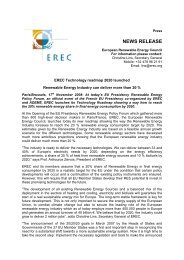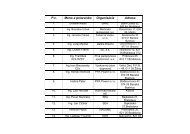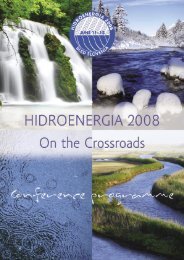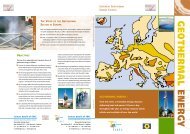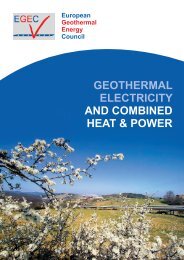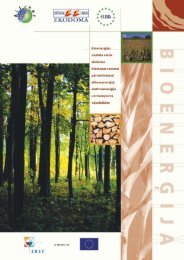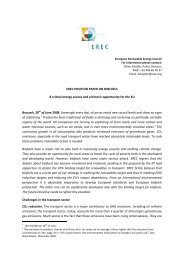geothermal electricity and combined heat & power - European ...
geothermal electricity and combined heat & power - European ...
geothermal electricity and combined heat & power - European ...
Create successful ePaper yourself
Turn your PDF publications into a flip-book with our unique Google optimized e-Paper software.
<strong>European</strong>GeothermalEnergyCouncilGeothermal Electricity <strong>and</strong>Combined Heat & PowerContentPageIntroduction 3Geothermal Power Systems 4Dry steam <strong>and</strong> Flash <strong>power</strong> plants 5Binary cycle <strong>power</strong> plants 6Geothermal CO 28Geothermal <strong>electricity</strong> history 9Geothermal <strong>electricity</strong> in Europe 10Geothermal <strong>electricity</strong> worldwide 12Combined Heat <strong>and</strong> Power 13EGEC | Geothermal Electricity <strong>and</strong> Combined Heat & Power
Dry steam <strong>and</strong>Flash <strong>power</strong> plantsDry steam <strong>power</strong> plants utilise straightforwardlysteam, which is piped fromproduction wells to the plant, then directedtowards turbine blades. The first, ever exploited,<strong>geothermal</strong> field, still in operation, at Larderelloin Italy, is among the very few drysteam fieldsrecorded worldwide.Flash steam <strong>power</strong> plantsConventional drysteam turbines require fluidsof at least 150°C <strong>and</strong> are available with eitheratmospheric (backpressure) or condensingexhausts. In the backpressure system steam ispassed through the turbine <strong>and</strong> vented to atmosphere.This cycle consumes twice more steamper produced kilowatt-hour (kWh), at identicalturbine inlet pressure, than a condensing cycle.However, backpressure turbines may proverewarding as pilot or/<strong>and</strong> st<strong>and</strong> by plants in caseof small supplies from remote isolated wells <strong>and</strong>for generating <strong>electricity</strong> in the early stages of fielddevelopment. They become m<strong>and</strong>atory in caseof high non condensable gas contents, in excessof 12% in weight, in the vapour phase.The steam, separated from the water, is piped tothe plant to drive a turbo-alternator. The separatedleft over brine, together with the condensedsteam, is piped back into the source reservoir, aninjection process meeting waste disposal, <strong>heat</strong>recovery, pressure maintenance <strong>and</strong>, last but notleast, resource sustainability requirements.Berlin 44 MWflash <strong>power</strong> plant -El Salvador.Condensing units are more complex in design,requiring more ancillary equipment <strong>and</strong> space <strong>and</strong>up to twice long construction/installation delays.Turbine specific steam consumption varies from8 to 10 t/h depending on temperature <strong>and</strong> pressure.55 to 60 MW eplant installed capacities are quitecommon but, recently, 110 MW eplants have beencommissioned <strong>and</strong> are currently operating.Flash steam plants, by far the most common,address water dominated reservoirs <strong>and</strong> temperaturesabove 180°C. The hot pressurised waterflows up the well until its pressure decreases tothe stage it vaporises, leading to a two phasewater-steam mixture <strong>and</strong> a vapour lift process.Larderello st<strong>and</strong>ard unitof 20 MW dry steam<strong>power</strong> plant - ItalyEGEC | Geothermal Electricity <strong>and</strong> Combined Heat & Power 5
Binary cycle <strong>power</strong> plantsBinary, known also as organic Rankinecycle (ORC), plants operate usually withwaters in the 100 to 180°C temperaturerange. In these plants, the <strong>heat</strong> is recoveredfrom the <strong>geothermal</strong> fluid, via a <strong>heat</strong> exchanger,to vaporize a low boiling point organic fluid<strong>and</strong> drive an organic vapour turbine. The <strong>heat</strong>depleted <strong>geothermal</strong> brine is pumped back intothe source reservoir, thus securing sustainableresource exploitation. Since the <strong>geothermal</strong><strong>and</strong> working fluids are kept separated duringthe process there are little if any, atmosphericemissions. Adequate working fluid selection mayallow to extend the former design temperaturerange from 180°C to 75°C.Upper <strong>and</strong> lower temperature limits depend onthe organic fluid stability <strong>and</strong> techno-economicconsiderations respectively. At low temperaturesthe size required by the <strong>heat</strong> exchangers coulddefeat project economic viability. Apart from lowto medium temperature utilisation, <strong>geothermal</strong><strong>and</strong> waste fluid binary processes can be contemplatedto avoid well scaling damage further toin-hole flashing, in which case submersiblepumps are used to produce the <strong>geothermal</strong> fluidunder pressure.Binary <strong>power</strong>plants.Binary processes are emerging as a cost effectiveconversion technology for recovering<strong>power</strong> from, water dominated, <strong>geothermal</strong>fields at temperatures below 180°C. Recently,a new c<strong>and</strong>idate binary process, known as theKalina cycle, has been developed, displayingattractive conversion efficiencies. It’s distinctivefeatures address an ammonia-water workingfluid mixture <strong>and</strong> regenerative <strong>heat</strong>ing. In brief,it takes advantage of the low boiling point of thewater-ammonia mixture to allow a significantfraction of it to be vaporised by the excess<strong>heat</strong> available at turbine exhaust. The gainsover conventional ORC plant efficiencies havebeen estimated at 40%, although its reliability<strong>and</strong> performances are yet to be demonstratedon long term plant service.Reclamation of low temperature <strong>geothermal</strong>sources, achievable via binary cycles, can significantlyincrease the overall worldwide exploitationpotential. Small scale <strong>geothermal</strong> binary plants(< 5 MW eratings) can be widely implemented inrural areas <strong>and</strong>, more generally, respond to anincreasingly disseminated human dem<strong>and</strong>.6 EGEC | Geothermal Electricity <strong>and</strong> Combined Heat & Power
10 MW eRibeiraGr<strong>and</strong>e binaryunit - AzoresIsl<strong>and</strong>s.Binary systems represent a means for upgradingoverall plant efficiencies of “conventional” flashcycles. Contrary to dry steam plants, where thewater phase reduces to steam condensates,flash units produce large amounts of separatedwater <strong>and</strong> waste <strong>heat</strong>, which remains lostunless otherwise utilised as <strong>heat</strong> proper (space<strong>heat</strong>ing/process <strong>heat</strong> for instance) or as binary<strong>power</strong> downstream from the flash steam turbine.This <strong>power</strong> cascading scheme produces lowcost energy extras at zero mining costs.200 kW eChenahot spring binaryunit using 74°C<strong>geothermal</strong>resource- Alaska2 MW eHusavikKalina binaryunit- Icel<strong>and</strong>EGEC | Geothermal Electricity <strong>and</strong> Combined Heat & Power 7
Geothermal CO 2Geothermal systems are located in areasexhibiting high CO 2fluxes inherent tothe geology of <strong>geothermal</strong> host structures.In volcanic environments much higherCO 2fluxes are the rule.Natural generationof CO 2in <strong>geothermal</strong>systemsFor instance, in Italy, in the Central West Tyrrhenianregion, large amounts of CO 2are producedat depth as a consequence of marine carbonaterock metamorphism. During their ascent, gasesget trapped in deep seated structures includingpermeable mesozoic limestones overlain byimpervious capping terrains, which becomesources of high CO 2upward flows. For thisreason, deep ground waters are enriched indissolved CO 2. Metamorphic processes affectingcarbonate phyllites can also contribute toCO 2production from shallow crustal levels atca 8 km depths <strong>and</strong> 400-500°C temperatures,higher than those (3-4 km; 200-300°C) of theoverlying <strong>geothermal</strong> reservoir.LarderelloNoteworthy is that natural CO 2production is independentfrom <strong>geothermal</strong> exploitation. Actually,surface manifestations, characterised by hotwater <strong>and</strong> steam discharges from springs <strong>and</strong>fractures, can create an environment hostile tohuman settlements (Larderello, Yellowstone).Thanks to industrial <strong>geothermal</strong> exploitation,deep, eventually toxic, <strong>geothermal</strong> fluids could bechannelled, via <strong>geothermal</strong> wells <strong>and</strong> collectinglines, to <strong>power</strong> plants concentrating on a singlepoint (the plant chimney) natural emissions, whichwould otherwise contaminate the surrounding soils<strong>and</strong> atmosphere over much larger areas.Summing up, <strong>geothermal</strong> CO 2emissions arenot generated by the industrial exploitationprocess.CO 2emission in <strong>electricity</strong> productionGeothermal,natural emission122Natural Gas315Oil760Coal9150 100 200 300 400 500 600 700 800 900 1000CO 2emission g/kWh8 EGEC | Geothermal Electricity <strong>and</strong> Combined Heat & Power
First experimentto produce<strong>geothermal</strong><strong>power</strong>, donein Italy in 1904by princeGinori ContiGeothermal <strong>electricity</strong> historyIn the early 1900’s, <strong>geothermal</strong> fluids werealready exploited for their energy content. Achemical industry was set up in Italy duringthat period, in the area known now as Larderello,to extract boric acid from natural hot water outletsor from purposely drilled shallow boreholes. Fromyears 1910 to 1940 the low pressure steam,in that area of Central Tuscany, was utilisedto <strong>heat</strong> industrial <strong>and</strong> residential buildings <strong>and</strong>greenhouses. In 1928, Icel<strong>and</strong>, another pioneerin the utilisation of <strong>geothermal</strong> energy, beganexploiting its abundant <strong>geothermal</strong> resources(mainly hot waters) for domestic <strong>heat</strong>ing.This application, exemplified by Italy, was followedby several countries. In Japan, the first <strong>geothermal</strong>wells were drilled in 1919 <strong>and</strong>, in 1929, at TheGeysers, California, in the USA. In 1958, a small<strong>geothermal</strong> <strong>power</strong> plant started operating in NewZeal<strong>and</strong>, in 1959 in Mexico, in 1960 in the USA,<strong>and</strong> in many other countries the following years.The first attempt to generate <strong>electricity</strong> from <strong>geothermal</strong>steam dates back to 1904 at Larderello.The success of this experiment (see illustration)proved the industrial value of <strong>geothermal</strong> energy<strong>and</strong> marked the beginning of an exploitation routethat was developed significantly since then. Actually,<strong>electricity</strong> generation at Larderello was acommercial success. By 1942 the installed geothermoelectriccapacity had reached 128 MWe.GeothermalBook - Italy.PanoramaLarderello -TodayEGEC | Geothermal Electricity <strong>and</strong> Combined Heat & Power 9
Geothermal <strong>electricity</strong> in EuropeAs far as <strong>geothermal</strong> <strong>electricity</strong> is concerned,the vast majority of eligible resources,in Continental Europe at large, isconcentrated in Italy, Icel<strong>and</strong> <strong>and</strong> Turkey; thepresently exploited potential represents so far0.3% of the whole renewable energy market.There are two major <strong>geothermal</strong> areas in Italy,Larderello-Travale/Radicondoli <strong>and</strong> Monte Amiatarespectively, achieving a 810 MW einstalledcapacity.They represent two neighbouring parts of thesame deep seated field, spreading over a huge,ca 400 km 2 , area, which produces super<strong>heat</strong>edsteam. On the Larderello side, the exploited area<strong>and</strong> installed capacity amount to 250 km 2 <strong>and</strong>562 MW erespectively. On the Travale/Radicondoliside, to the Southeast, the installed capacity is160 MW e<strong>and</strong> the exploited area 50 km 2 . Thesteam condensates recovered from Travale arereinjected into the core of the Larderello field,via a 20 km long water pipeline.The Monte Amiata area, in Northern Latium,includes two water dominated <strong>geothermal</strong> fields,Piancastagnaio <strong>and</strong> Bagnore. On both fields a deepresource has been identified under the shallowproducing horizons. Weak social acceptance fromthe local communities are slowing down the fulldevelopment of the promising, high potential, deepreservoir. Presently, five units are operating, one inBagnore <strong>and</strong> four in Piancastagnaio, totalling a 88MWe installed capacity. Projects, adding a further100 MW ecapacity, have been commissioned <strong>and</strong>will be completed in the near future.Geothermal resources in Icel<strong>and</strong> relate to the activevolcanic environment of the isl<strong>and</strong>, located onthe mid-Atlantic ridge <strong>and</strong> its sea floor spreadingattributes. Icel<strong>and</strong> has proved a leading countryin direct uses of <strong>geothermal</strong> energy, mainly ingreenhouse <strong>and</strong> district <strong>heat</strong>ing (89% of the totaldomestic <strong>heat</strong>ing dem<strong>and</strong>) <strong>and</strong> is increasing its<strong>electricity</strong> production, which reached (@2006) a420 MW einstalled capacity. Although significant,this capacity ought to be compared to the hugepotential of the isl<strong>and</strong>, estimated at ca 4000 MW e,a figure far above national <strong>power</strong> requirements,ca 1500 MW e, among which hydro<strong>power</strong> holdsthe dominant share (1300 MW e).Turkey’s <strong>geothermal</strong> resources are mainly locatedin Western Anatolia on the Aegean sea façade.District <strong>heat</strong>ing st<strong>and</strong>s presently as the mostimportant utilisation with 65000 <strong>heat</strong>ed homes.This, in spite of mild climatic conditions which stillmakes <strong>geothermal</strong> <strong>heat</strong> competitive as a resultof the high cost of electric <strong>heat</strong>ing, 8 to 10 timeshigher than <strong>geothermal</strong> <strong>heat</strong>. Electricity productionin the Kizildere water dominated field is suppliedby a 15 MW edesign plant (start up, 1988) capacity,actually st<strong>and</strong>ing at 12 MW e. Binary plantshave been commissioned. The largest geo<strong>power</strong>(flashed steam) plant, rated 45 MW e, is presently inadvanced construction stage at Germencek. Thenational <strong>geothermal</strong> <strong>electricity</strong> potential has been(conservatively) estimated at 200-300 MW e.In Greece, high temperature <strong>geothermal</strong> resourcesare located in the Aegean volcanicisl<strong>and</strong> arc, in the Milos (Cyclades) <strong>and</strong> Nisyros(Dodecanese) isl<strong>and</strong>s, thanks to direct drilling<strong>and</strong> testing assessments. Electricity generationfrom a 2 MW erated pilot plant ceased further tothe strong opposition of the local community <strong>and</strong>mismanaged communication by the <strong>geothermal</strong>operator. The country potential in the Aegeanarchipelagos <strong>and</strong>, at a lesser extent through, inthe northern, mainl<strong>and</strong> located, grabensis estimated at ca 200 MW e. Otherwise,several low temperature fields areexploited, on presently limited bases,for greenhouse <strong>heat</strong>ing <strong>and</strong> process<strong>heat</strong> applications.In Russia, geoelectric development tookplace in the Mutuovski field of Kamchatkawhich, although belonging politically toEurope, ought to be regarded as geogra-Icel<strong>and</strong>Krafla, Icel<strong>and</strong>10 EGEC | Geothermal Electricity <strong>and</strong> Combined Heat & Power
approximately from 2 to 4.5 €/MW,<strong>and</strong> very attractive generation costs,from 40 to 100 €/MWh. It is a resourcesuitable for base load <strong>power</strong>.Geothermal<strong>electricity</strong>worldwideThe growth of developing countries willresult in a two fold increase of the global<strong>electricity</strong> dem<strong>and</strong> over the next 25 years,from 15,000 TWh in 2005 to 30,000 TWh in 2030.The present renewable energy quota is 21.5%(mainly hydro), while the projected share will be25.8% in 2030.Geothermal Energy provides approximately 0.4%of the world global <strong>power</strong> generation, with a stablelong term growth rate of 5%. At present, the largestmarkets are in the USA, Philippines, Mexico, Indonesia,Italy <strong>and</strong> Icel<strong>and</strong>. Future developments arelimited to areas worldwide, particularly under currenttechnologies. The present installed capacity of 9GW will increase up to 11 GW in 2010. It displaysinvestment costs, depending on the quality of theresource (temperature, fluid chemistry <strong>and</strong> thermodynamicsphase, well deliverability,..), rangingIt can be considered as broadlycost-competitive, despite relativelyhigh capital investment costs forthe development of the <strong>geothermal</strong>field (resource assesment, miningrisk, drilling <strong>and</strong> piping), owing toits very high availability <strong>and</strong> stableenergy production. The next generationshould be able to benefit fromthe implementation of the Enhanced GeothermalSystem (EGS) production, alongside an intensiveincrease of low-to-medium temperature applicationsthrough binary cycles <strong>and</strong> cascading uses.Geothermal <strong>electricity</strong> potentialEstimating the overall worldwide potential is adelicate exercise due to the many uncertaintiesinvolved. Nevertheless, it is possible to identify arange of estimates, by taking into considerationalso the possible impacts of new technologies (permeabilityenhancements, drilling improvements,EGS, low temperature <strong>electricity</strong> generation).Minimum: 35,000/70,000 MWMaximum 140,000 MWIt is deemed possible to produce up to a maximumof 1,000 billion kWh of <strong>electricity</strong> annually, i.e.8.3% of total world <strong>electricity</strong> production, serving17% of the world population. 39 countries (mostlyin Africa, Central/South America <strong>and</strong> the Pacific)can be wholly <strong>geothermal</strong>ly <strong>power</strong>edWorld Geothermal PotentialInstalled Capacity Wordlwide150,000 MW12 GW10 GW100,000 MW8 GW50,000 MW0 Current Today’sTechnology EnhancedTechnology6 GW4 GW2 GW01980 1990 2000 2010Installedcapacity from1975 up toend of 2007(light blue) <strong>and</strong>to 2010 (red).12 EGEC | Geothermal Electricity <strong>and</strong> Combined Heat & Power
SvartsengiPower Plantaerial viewCombined Heat& PowerGeothermal CHP is nothing new. As amatter of fact, a low temperature (81 °C)<strong>geothermal</strong> resource has been exploited,since the late 1960’s, at Paratunka, Kamchatka,Russia, combining <strong>power</strong> generation (680 kW einstalled capacity) <strong>and</strong> direct uses of the (huge)waste <strong>heat</strong> for soil <strong>and</strong> greenhouse <strong>heat</strong>ingpurposes. Such a temperature cascading use iswhat <strong>geothermal</strong> CHP is all about. Actually,<strong>heat</strong>may be regarded as a by product of <strong>geothermal</strong><strong>power</strong> production in terms of either waste <strong>heat</strong>released by the generating units or excess <strong>heat</strong>from the <strong>geothermal</strong> source. The latter opportunityhas been exploited by the Sudurness GeothermalDistrict Heating Corporation in Icel<strong>and</strong>.Here, steam from the nearby high enthalpy, liquiddominated, field <strong>heat</strong>s, up to 95-105°C, coldground water, which is piped to nine surroundingcities <strong>and</strong> the Kevlafik International Airport. Thiscogeneration scheme, unique of its kind, secures45 MW e<strong>and</strong> 150 MW th<strong>power</strong> <strong>and</strong> <strong>heat</strong> capacitiesrespectively, indeed a true <strong>geothermal</strong> paradise,combining, equally shared, <strong>power</strong> generation<strong>and</strong> <strong>heat</strong>ing issues.Sudurnes Regional HeatingSystem LayoutPower generation from medium enthalpy sources,st<strong>and</strong>ing in the 100-150°C temperature range,by using a low boiling point working fluid <strong>and</strong>an organic vapour turbine, a conversion processknown as the Organic Rankine Cycle (ORC), canhardly seek economic viability, unless a <strong>heat</strong>ingsegment be added to the utilisation grid.EGEC | Geothermal Electricity <strong>and</strong> Combined Heat & Power 13
What can we do with <strong>geothermal</strong> energyOver the last decades a growing concern on environmental issues has been spreading aroundthe world’s people, <strong>and</strong>, contemporaneously, the dem<strong>and</strong> of energy was shooting up too. It isalso evident that energy sources are not equally distributed among the countries <strong>and</strong> quite oftendeveloping nations cannot afford buying fossil fuels abroad to supply their industries <strong>and</strong> to warm theirdwellings. It is clear that an indigenous <strong>and</strong> easily exploitable energy source is needed in many countriesaround the world to give a boost to local activities <strong>and</strong> support a self-sustaining economic growth.Geothermal energy can then represent a viable, local <strong>and</strong> environmental friendly solution for many suchcountries. In fact, <strong>geothermal</strong> energy is almost ubiquitously available <strong>and</strong> could be used to spare fossilfuels in dealing with different processes. Moreover, no burning is involved <strong>and</strong> no manmade emissions willaffect the area (any <strong>geothermal</strong> area is already characterised by gas emissions which escape naturallyfrom the ground, but no combustion is involved <strong>and</strong> the clouds over <strong>geothermal</strong> plants are made ofsteam). Also, there is no radioactive waste.In a few words, <strong>geothermal</strong> is a clean, reliable <strong>and</strong> baseload energy (available year round <strong>and</strong> roundthe clock), that save money at home (no fuel to be imported from abroad), <strong>and</strong> can create jobs in localcommunities. In addition, it helps the implementation of the Kyoto Protocol <strong>and</strong> of the EU objectives.<strong>European</strong>GeothermalEnergyCouncilContact:EGEC - <strong>European</strong> Geothermal Energy Council a.s.b.l.Renewable energy House63-65 rue d’ArlonB-1040 BrusselsT : + 322 400 10 24F : + 322 400 10 10W : www.egec.orgE : info@egec.orgThe sole responsibility for the content of this publication lies with theauthors. It does not necessarily reflect the opinion of the <strong>European</strong>Communities. The <strong>European</strong> Commission is not responsible forany use that may be made of the information con-tained therein.Supported byPhoto <strong>and</strong> graphical elements credits : EGEC, Geotec Consult,Geothermal Education Office - California, ENEL, IGA, ORMAT, Enex,GRC, Orkustofnun, Geo<strong>heat</strong> Center (OIT), City of Altheim, GTN,Geofluid, G.E.I.E. Exploitation Minière de la Chaleur.Published in December 2007 - Text: Ruggero Bertani <strong>and</strong>Pierre Ungemach - Design: ACG Brussels - Printed onecologically friendly paper (chlorine-free paper)


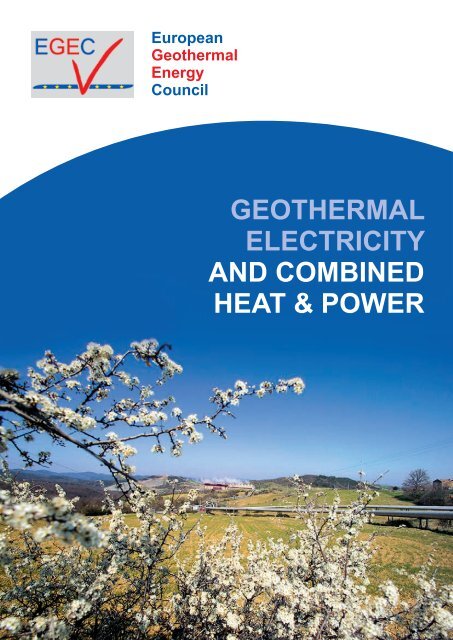

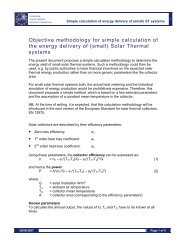
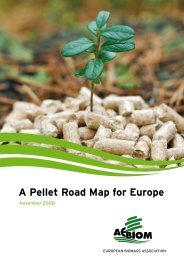
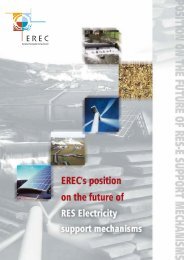

![Energy [R]evolution - Greenpeace](https://img.yumpu.com/47174859/1/184x260/energy-revolution-greenpeace.jpg?quality=85)
